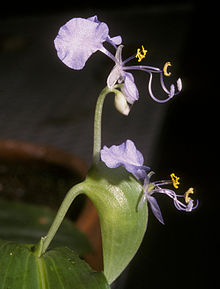Commelina lukei
| Commelina lukei | |
|---|---|
 |
|
| Male and bisexual flowers, on a plant grown from a cutting of William Richard Quentin Luke's collection. | |
| Scientific classification | |
| Kingdom: | Plantae |
| (unranked): | Angiosperms |
| (unranked): | Monocots |
| (unranked): | Commelinids |
| Order: | Commelinales |
| Family: | Commelinaceae |
| Subfamily: | Commelinoideae |
| Tribe: | Commelineae |
| Genus: | Commelina |
| Species: | C. lukei |
| Binomial name | |
|
Commelina lukei Faden |
|
Commelina lukei is a monocotyledonous, herbaceous plant in the dayflower family from East Africa. This blue-flowered herb has been recorded in lowland areas of Kenya, Tanzania (including Zanzibar), and Madagascar, where it is found in a variety of habitats ranging from forests to grasslands to roadsides. Described in 2008, the species was previously confused with Commelina mascarenica and Commelina imberbis. Despite this misinterpretation, a third similar species, Commelina kotschyi, is actually most closely related to C. lukei. The plant's distinctive features include a scrambling habit, capsules with a rounded extension at the apex, appendaged seeds, clasping leaf bases throughout, and solely needle-like hairs along the upper side of the leaf's midrib. The species was named in honour of the botanist W. Q. R. Luke, whose collection of the plant served as the type specimen and allowed for a complete illustration and description.
Commelina lukei was previously confused with the similar species Commelina imberbis. While a number of morphological characters are now known which can consistently separate these two species, the most obvious ones typically did not survive on collected specimens, in particular seed, capsules, and the shape of floral organs. It was later found that plants thought to be C. imberbis from coastal East Africa were in fact a separate species previously only recorded from Madagascar, namely Commelina mascarenica, which meant that this third species had also been confused with C. lukei. The confusion was driven by the fact that C. imberbis and C. mascerenica both share certain key features with C. lukei, including leaves which clasp the stem, solitary and only slightly hairy spathes with shortly fused margins, and blue flowers. Furthermore, the capsules and seeds, while distinctive upon close inspection, are superficially quite similar.
...
Wikipedia

